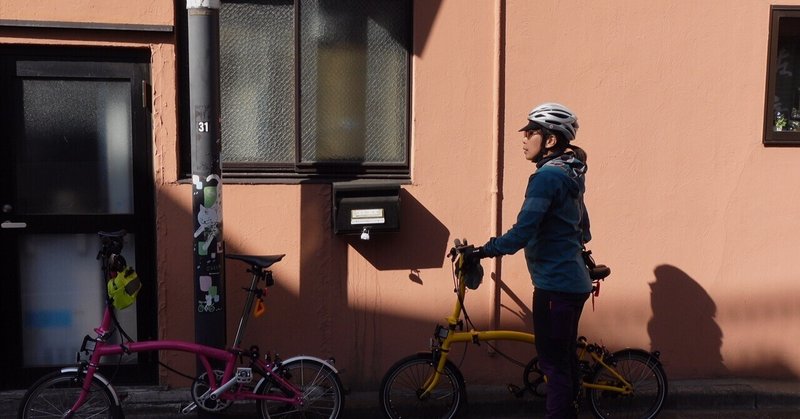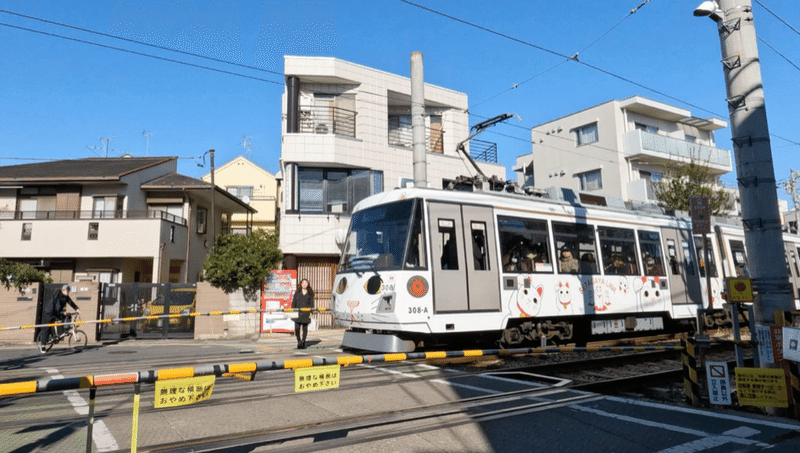
Setagaya Ride with Brompton
A few weeks after my husband and I uploaded our first YouTube video of a ride around Tokyo with Brompton folding bicycle, we decided to film a second ride starting at Ueno and a third ride in Setagaya, starting at Shimokitazawa and finishing at Futakotamagawa.
折り畳み自転車ブロントンで東京を巡るライドをYouTubeで最初にアップしてから数週間、2回目は上野発のライドを撮影し、3回目は下北沢発、二子玉川ゴールの世田谷ライドにしようと決めた。
Departing from Shimokitazawa Station on a holiday morning. After a cup of coffee at SIDE WALK COFFEE ROASTERS, where you can relax on the open terrace, we went through the shopping and residential area to Setagaya-Daita Station.
Kannana Dori Street runs near Setagaya-Daita Station, and there are cute murals painted on the sidewalk. It is fun to take a walk while taking pictures.
休日の朝、下北沢駅を出発。開放的なテラスでのんびりできる、SIDE WALK COFFEE ROASTERSでコーヒーを飲んだあと、商店街や住宅地を抜け、世田谷代田駅へ。
世田谷代田駅の近くには環七通りが走っていて、歩道にはかわいい壁画が描かれている。写真を撮りながら散歩するのも楽しい。
We passed through Umegaoka, where ume (Japanese apricot, Chinese plum) trees are beginning to bloom even though it is still early February, to Gotokuji Temple.
Gotokuji is famous for its beckoning cats “Manekineko”. It is fun to see electric poles and signs with cats painted on them not only around Gotokuji Station, but also around Setagaya and Kamimachi stations on the Setagaya Line, where the Setagaya Ward Office is located. The Setagaya Line also has a beckoning cat train that runs several times a day.
まだ2月の初めだというのに、梅がポツポツと咲き始めている梅ヶ丘を抜け、豪徳寺へ。
豪徳寺といえば招き猫だ。豪徳寺駅周辺ははもちろん、世田谷区役所のある世田谷線の世田谷や上町の駅周辺にも、猫の絵が描かれた電柱や看板に出会えて楽しい。世田谷線には1日に数本、招き猫電車も走っている。
We stopped my bike in front of Gotokuji Temple and walked in. Lots of cats, cats, cats.... Many foreign tourists were taking commemorative photos. The beckoning cat at Gotokuji does not hold a koban, but rather raises its right hand. It is said that the Gotokuji beckoning cat invites people and brings "karma" .
豪徳寺の前で自転車を止めて、歩いて中に入った。たくさんの猫、猫、猫…。記念撮影をしている外国人観光客も多い。豪徳寺の招き猫は小判を持っておらず、右手を上げている。人を招き、「縁」をもたらしてくれるのだという。
I decided to buy one of the small, cute Manekineko, and take it home with me. The cat seemed to be very popular, and there was a sign saying that each person was limited to one cat.
せっかくなので、小さなかわいい招福猫児(まねきねこ)を1つ購入し、家に連れて帰ることにした。人気らしく、お一人様一つまでの案内がされていた。
Next is Shoin Shrine. This shrine is dedicated to Shoin Yoshida, an educator and thinker at the end of the Edo period. After visiting the shrine, we had lunch at a curry café diagonally across the street. It was not a long drive, but we were taking our time while taking pictures, and it was around 12:00 noon.
お次は松陰神社。幕末の教育者であり、思想家の吉田松陰が祀られた神社だ。お参りをしたあと、斜向かいにあるカレーカフェで、ランチを食べることにした。たいした距離は走っていないけれど、撮影をしながらゆっくり回っていたら、12時を回ってしまったのだ。
There are many cafes in this area, and it is not difficult to find a place to rest for a small group of people. However, there are many small stores, so if there is a large number of people, the number of places you can go may be limited.
このあたりはカフェが多く、少人数で回る分には休憩場所には困らない。小さなお店が多いので、人数が多いと入れるお店が限られてしまうかもしれない。
We went to Sangenjaya and returned to our original direction via a path near the Setagaya Line tracks.
The Setagaya Line is one of Tokyo's two remaining trams (along with the Toden Arakawa Line). The train is a tranquil two-car train, and it is somewhat amusing to see it waiting at traffic lights as it crosses Kannana-dori Street, which passes near Wakabayashi Station.
三軒茶屋まで走り、世田谷線の線路近くの道通って元きた方角に戻った。
世田谷線は都電荒川線と並び、現在都内に残る2つの路面電車のうちの1つだ。2両編成ののどかな電車で、若林駅の近くを通る環七通りを渡る際には、信号待ちをする姿もなんだかほほえましい。
Returning to the Setagaya area, we turned around and headed south.
Crossing Tsurumaki-dori Avenue and going a little further, We spotted a sign that read "Twin Water Towers" and stopped.
世田谷あたりまで戻り、向きを変えて南へ。
弦巻通りを渡って少し行くと、双子の給水塔という標識を見つけ、立ち止まった。
The two huge towers are decorated with decorative light bulbs reminiscent of crowns, giving them a Western medieval look. It is said to have served as the model for the hideout of Edogawa Rampo's "The Phantom with Twenty Faces. Currently, it functions as an emergency water tank.
ここは大正時代に建てられた駒沢給水塔で、2基の巨大給水塔には王冠を連想させる装飾電球がつけられ、西洋の中世風の趣をもつ。江戸川乱歩の怪人二十面相のアジトのモデルにもなったのだとか。現在は非常時用の応急級水槽として機能しているという。
Located in a residential area and currently inaccessible from the street, it is inconspicuous from the street, but a quick circle around the perimeter reveals two towers and a truss bridge connecting them from the other side of the wall.
住宅地の中にあり、現在は中に入ることができないため通りからは目立たないが、周囲をぐるっと1周回ってみると、反対側から壁越しに2つの塔と、間を結ぶトラス橋を見ることができた。
Next, we went to Sakurashinmachi. Sakurashinmachi is the town where Machiko Hasegawa, the author of Sazae-san, lived before her death and is considered a place associated with Sazae-san. There is a statue of the Sazae-san family in front of the station, and statues and murals of Sazae-san can be seen here and there in banks, police boxes, and shopping streets.
続いて、桜新町へ。桜新町はサザエさんの作者である長谷川町子さんが生前住んでいた街で、サザエさんゆかりの地とされている。駅前にはサザエさん一家像があり、銀行にも交番にも商店街にも、サザエさんの像や壁画があちこちで見られる。
As its name suggests, Sakura-shinmachi is also famous for its rows of cherry trees. The rows of cherry trees in the former Shinmachi residential area (present-day Sakura-shinmachi 1-chome to Fukasawa 7-8-chome) were planted in 1913, when this area became the first residential subdivision in the Kanto region, and was the first residential area in Japan to be successfully lined with Someiyoshino cherry trees. This is also the origin of the current name of the area, "Sakurashinmachi.
桜新町にはその名の通り、桜並木の名所もある。旧新町住宅地(現在の桜新町1丁目から深沢7〜8丁目)にある桜並木は、1913年にこのあたりが関東初の分譲住宅地として分譲が始まった際、日本で初めて住宅地にソメイヨシノの桜並木を植えて成功したのだそう。それが「桜新町」という現在の地名の由来にもなっている。
Passing near Komazawa Park, we headed for Jiyugaoka. The area around Jiyugaoka station is the border between Setagaya and Meguro wards.
Crossing a bridge over the Todoroki ravine, the ride ended at Futakotamagawa station with a final stop at a cafe.
The distance traveled was about 25 km, stopping and walking slowly along the way. The sunlight had turned to evening orange.
駒沢公園の近くを通り、自由が丘へ。自由が丘の駅の周辺は、世田谷区と目黒区の境目だ。
等々力渓谷の橋を渡り、最後にカフェに立ち寄って、二子玉川駅でライド終了。
途中で立ち止まったり、歩いたりしながらゆっくり、走行距離は約25km。光はすっかり夕方のオレンジ色に変わっていた。

テラスが広いSIDE WALK COFFEE ROASTERS SHIMOKITAZAWA。

Mt.Fuji can be seen beautifully.
世田谷代田駅は駅前が広場になっていて、天気がよいと富士山がきれいに見える。

小田急線豪徳寺駅の招き猫像の前で記念撮影。豪徳寺駅は世田谷線山下駅のすぐ近く。



豪徳寺の境内では、梅の花がたくさん咲いていた。

ランチは松陰神社の斜向かいにあるゴーダカフェにて

a mere 5 km and 10 stations in 18 minutes.
下高井戸から三軒茶屋のわずか5km、10駅を18分で結ぶ東京の路面電車、世田谷線

日に数回、世田谷線には招き猫電車が走る。


サザエさんと桜の街、桜新町。

We had delicious coffee, cake, and pudding in a cozy space.
最後に、YETI ROSTERY COFFEEでカフェタイム。
居心地のよいすてきな空間で、おいしいコーヒーとケーキ、プリンをいただいた。
Brompton Setagaya Ride. click here for YouTube video.
ブロンプトン世田谷ライド。YouTubeの動画はこちら
この記事が気に入ったらサポートをしてみませんか?
